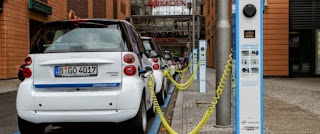Electric vehicles will become cheaper than the internal combustion engine in a half decade, while electric buses will completely “dominate” its sector by the late-2020s, according to Bloomberg New Energy Finance (BNEF), which just published its Electric Vehicle Outlook 2018 report.
EV sales will top 1.6 million in 2018, up from just a few hundred thousand in 2014, according to BNEF. The acceleration in sales can be chalked up to a few factors. First, battery costs have declined by 79 percent since 2010, falling from over $1,000 per kilowatt-hour to just $209/kWh at the end of 2017. Energy density has also increased by 5 to 7 percent each year. Costs could drop to as low as $70/kWh by 2030.
Second, governments continue to support EVs with various forms of subsidies or other policy help.
The third reason can be summed up in one word: China. Roughly 21 percent of all EV sales in 2017 occurred in just six Chinese cities. China is offering an array of carrots, but also sticks, including restrictions on buying and using gasoline or diesel vehicles. By 2025 China will account for roughly half of the entire global EV market.
Another reason is the proliferation of new EV models from a long line of automakers. The number of EV models is expected to nearly double from 155 at the end of 2017 to as many as 289 by 2022.
Obviously, it isn’t all rosey for the EV industry. EVs still only account for less than 2 percent of the auto market in most of the world. There is also a lack of recharging infrastructure in most markets.
Meanwhile, key ingredients used in lithium-ion batteries, such as cobalt, have seen costs skyrocket as demand has increased. Without significant investment in new cobalt capacity, for instance, there could be shortages within a few years. “If capacity does not grow as planned, cobalt prices could continue to spike and there could be a major cobalt shortage,” BNEF analysts said. “This would have serious implications on the electric vehicle market.”
Cobalt prices have already tripled in the past two years, and with supply lagging demand, prices could continue to rise. The problem is all the more worrying because new mines have long lead times, which sets the market up for some serious speed bumps in the early 2020s.
Nevertheless, the BNEF forecast is bullish for EVs. Sales are expected to continue to accelerate, topping 11 million units by 2025 and 30 million by 2030. By 2040 EV sales will hit 60 million, or about 55 percent of the global market for light-duty vehicles. Cumulatively, about 559 million EVs will be on the roads in 2040, or about a third of the global fleet.
On an unsubsidized basis, EVs will hit cost parity with gasoline- and diesel-powered vehicles by about 2024, causing the latter to see declining sales after that point “as EVs bite hard into their market,” BNEF says.
Many of the BNEF projections are similar to last year’s report, although some of the near-term projections appear more bullish. But one of the more eye-opening forecasts is for electric buses. Consider this statement: “The advance of e-buses will be even more rapid than for electric cars,” BNEF concluded.
Electric buses will reach cost parity with conventional municipal buses as soon as next year, BNEF says. And whereas EVs will capture 28 percent of the market by the late 2020s, e-buses will “dominate” its segment, making up 84 percent of the bus market by the same date. “China has led this market in spectacular style, accounting for 99 percent of the world total last year. The rest of the world will follow, and by 2040 we expect 80 percent of the global municipal bus fleet to be electric,” Colin McKerracher, lead analyst on advanced transportation for BNEF, said in a statement.
What is the upshot for crude oil? The penetration of EVs into the light-duty vehicle market will erase 7.3 million barrels per day of oil demand by 2040.
Oil prices are largely determined at the margins, with small discrepancies between supply and demand responsible for wild swings in prices. In that context, while demand will still be enormous in 10 or 20 years, the demand destruction stemming from EVs and e-buses present a mortal threat to high oil prices.
Read more at EVs Could Erase 7 Million Bpd in Demand

No comments:
Post a Comment